A Deep Learning Approach to Classify Surgical Skill in Microsurgery Using Force Data from a Novel Sensorised Surgical Glove
Abstract
:1. Introduction
1.1. Background
Problem Definition
1.2. Related Work
1.3. Contributions
- Our work represents the original effort to address Force-based automated Skill Classification (FSC) in microsurgery.
- We establish a benchmark for FSC, including six prominent deep learning architectures and six data augmentation techniques. This benchmark is accompanied by a comprehensive analysis, both in quantitative and qualitative aspects, to provide valuable insights for future research in this domain.
- We build a novel FSC dataset, comprising 236 trials conducted by 13 surgeons, which includes time-series force data with corresponding skill level annotations. Two dataset split settings, namely random split and Leave-One-User-Out (LOUO), are applied to train the proposed benchmark, presenting the first demonstration of how to use and evaluate this new dataset.
- Experimental results on the proposed dataset show that the temporal convolutional network with time warp data augmentation achieves the highest 97.46% accuracy for the random split setting, and the convolutional long short-term deep neural network with time warp data augmentation reaches the best 96.48% accuracy for the LOUO setting.
2. Materials and Methods
2.1. Dataset
2.1.1. Surgical Task and Participants
2.1.2. Hardware Description
Materials
Sensor Fabrication
Sensorized Glove Fabrication
Sensor Calibration
2.1.3. Data Preprocessing
2.2. Classification Models
2.2.1. Long Short-Term Memory
2.2.2. Bidirectional Long Short-Term Memory
2.2.3. Gate Recurrent Unit
2.2.4. Convolutional Long Short-Term Memory Deep Neural Network
2.2.5. Temporal Convolution Network
2.2.6. Transformer Network
2.3. Data Augmentation
2.3.1. Fast Fourier Transform
2.3.2. Quantization
2.3.3. Drift
2.3.4. Time Warp
2.3.5. Gaussian Noise
2.3.6. Temporal Jittering
3. Experiments and Results
3.1. Evaluation Protocol
3.2. Implementation Details
3.3. Performance Analysis
3.4. Data Augmentation Analysis
3.5. Qualitative Analysis
3.6. Limitations
3.6.1. Hardware and Study Limitations
3.6.2. Algorithm Limitations
4. Conclusions
Author Contributions
Funding
Institutional Review Board Statement
Informed Consent Statement
Data Availability Statement
Conflicts of Interest
References
- Tamai, S. History of microsurgery. Plast. Reconstr. Surg. 2009, 124, e282–e294. [Google Scholar] [CrossRef] [PubMed]
- Lascar, I.; Totir, D.; Cinca, A.; Cortan, S.; Stefanescu, A.; Bratianu, R.; Udrescu, G.; Calcaianu, N.; Zamfirescu, D.G. Training program and learning curve in experimental microsurgery during the residency in plastic surgery. Microsurgery 2007, 27, 263–267. [Google Scholar] [CrossRef] [PubMed]
- Birkmeyer, J.D.; Finks, J.F.; O’Reilly, A.; Oerline, M.; Carlin, A.M.; Nunn, A.R.; Dimick, J.; Banerjee, M.; Birkmeyer, N.J. Surgical Skill and Complication Rates after Bariatric Surgery. N. Engl. J. Med. 2013, 369, 1434–1442. [Google Scholar] [CrossRef] [PubMed]
- McQueen, S.; McKinnon, V.; VanderBeek, L.; McCarthy, C.; Sonnadara, R. Video-Based Assessment in Surgical Education: A Scoping Review. J. Surg. Educ. 2019, 76, 1645–1654. [Google Scholar] [CrossRef] [PubMed]
- James, H.K.; Gregory, R.J.H. The dawn of a new competency-based training era. Bone Jt. Open 2021, 2, 181–190. [Google Scholar] [CrossRef] [PubMed]
- Stefanidis, D. Optimal acquisition and assessment of proficiency on simulators in surgery. Surg. Clin. N. Am. 2010, 90, 475–489. [Google Scholar] [CrossRef] [PubMed]
- Milling, R.; Carolan, D.; Pafitanis, G.; Quinlan, C.; Potter, S. Microtools: A systematic review of validated assessment tools in microsurgery. J. Plast. Reconstr. Aesthetic Surg. 2022, 75, 4013–4022. [Google Scholar] [CrossRef] [PubMed]
- Tang, B.; Hanna, G.B.; Cuschieri, A. Analysis of errors enacted by surgical trainees during skills training courses. Surgery 2005, 138, 14–20. [Google Scholar] [CrossRef]
- Sugiyama, T.; Lama, S.; Gan, L.S.; Maddahi, Y.; Zareinia, K.; Sutherland, G.R. Forces of tool-tissue interaction to assess surgical skill level. JAMA Surg. 2018, 153, 234–242. [Google Scholar] [CrossRef]
- Golahmadi, A.K.; Khan, D.Z.; Mylonas, G.P.; Marcus, H.J. Tool-tissue forces in surgery: A systematic review. Ann. Med. Surg. 2021, 65, 102268. [Google Scholar] [CrossRef]
- Rosen, J.; Hannaford, B.; Richards, C.G.; Sinanan, M.N. Markov modeling of minimally invasive surgery based on tool/tissue interaction and force/torque signatures for evaluating surgical skills. IEEE Trans. Biomed. Eng. 2001, 48, 579–591. [Google Scholar] [CrossRef]
- Leong, J.J.H.; Nicolaou, M.; Atallah, L.; Mylonas, G.P.; Darzi, A.W.; Yang, G.Z. HMM assessment of quality of movement trajectory in laparoscopic surgery. Comput. Aided Surg. 2007, 12, 335–346. [Google Scholar] [CrossRef] [PubMed]
- Kelly, J.D.; Petersen, A.; Lendvay, T.S.; Kowalewski, T.M. Bidirectional long short-term memory for surgical skill classification of temporally segmented tasks. Int. J. Comput. Assist. Radiol. Surg. 2020, 15, 2079–2088. [Google Scholar] [CrossRef] [PubMed]
- Zia, A.; Sharma, Y.; Bettadapura, V.; Sarin, E.L.; Essa, I. Video and accelerometer-based motion analysis for automated surgical skills assessment. Int. J. Comput. Assist. Radiol. Surg. 2018, 13, 443–455. [Google Scholar] [CrossRef] [PubMed]
- Zhang, D.; Wu, Z.; Chen, J.; Gao, A.; Chen, X.; Li, P.; Wang, Z.; Yang, G.; Lo, B.; Yang, G.Z. Automatic Microsurgical Skill Assessment Based on Cross-Domain Transfer Learning. IEEE Robot. Autom. Lett. 2020, 5, 4148–4155. [Google Scholar] [CrossRef]
- Bissonnette, V.; Mirchi, N.; Ledwos, N.; Alsidieri, G.; Winkler-Schwartz, A.; Maestro, R.F.D. Artificial Intelligence Distinguishes Surgical Training Levels in a Virtual Reality Spinal Task. J. Bone Jt. Surg.-Am. Vol. 2019, 101, e127. [Google Scholar] [CrossRef]
- Horsfall, H.L.; Mao, Z.; Koh, C.H.; Khan, D.Z.; Muirhead, W.; Stoyanov, D.; Marcus, H.J. Comparative Learning Curves of Microscope Versus Exoscope: A Preclinical Randomized Crossover Noninferiority Study. Front. Surg. 2022, 9, 920252. [Google Scholar] [CrossRef] [PubMed]
- Ullah, S.; Bustam, M.A.; Nadeem, M.; Naz, M.Y.; Tan, W.L.; Shariff, A.M. Synthesis and thermal degradation studies of melamine formaldehyde resins. Sci. World J. 2014, 2014, 940502. [Google Scholar] [CrossRef]
- Trejos, A.L.; Patel, R.V.; Malthaner, R.A.; Schlachta, C.M. Development of force-based metrics for skills assessment in minimally invasive surgery. Surg. Endosc. 2014, 28, 2106–2119. [Google Scholar] [CrossRef]
- Cundy, T.P.; Thangaraj, E.; Rafii-Tari, H.; Payne, C.J.; Azzie, G.; Sodergren, M.H.; Yang, G.Z.; Darzi, A. Force-Sensing Enhanced Simulation Environment (ForSense) for laparoscopic surgery training and assessment. Surgery 2015, 157, 723–731. [Google Scholar] [CrossRef]
- Horeman, T.; Rodrigues, S.P.; Willem Jansen, F.; Dankelman, J.; van den Dobbelsteen, J.J. Force Parameters for Skills Assessment in Laparoscopy. IEEE Trans. Haptics 2012, 5, 312–322. [Google Scholar] [CrossRef]
- Brown, J.D.; O’Brien, C.E.; Leung, S.C.; Dumon, K.R.; Lee, D.I.; Kuchenbecker, K.J. Using Contact Forces and Robot Arm Accelerations to Automatically Rate Surgeon Skill at Peg Transfer. IEEE Trans. Biomed. Eng. 2017, 64, 2263–2275. [Google Scholar] [CrossRef]
- Rafii-Tari, H.; Payne, C.J.; Liu, J.; Riga, C.; Bicknell, C.; Yang, G.Z. Towards automated surgical skill evaluation of endovascular catheterization tasks based on force and motion signatures. In Proceedings of the 2015 IEEE International Conference on Robotics and Automation (ICRA), Seattle, WA, USA, 26–30 May 2015; pp. 1789–1794. [Google Scholar] [CrossRef]
- Rivas-Blanco, I.; Pérez-Del-Pulgar, C.J.; García-Morales, I.; Muñoz, V.F. A Review on Deep Learning in Minimally Invasive Surgery. IEEE Access 2021, 9, 48658–48678. [Google Scholar] [CrossRef]
- Wang, Z.; Majewicz Fey, A. Deep learning with convolutional neural network for objective skill evaluation in robot-assisted surgery. Int. J. Comput. Assist. Radiol. Surg. 2018, 13, 1959–1970. [Google Scholar] [CrossRef] [PubMed]
- Ismail Fawaz, H.; Forestier, G.; Weber, J.; Idoumghar, L.; Muller, P.A. Evaluating Surgical Skills from Kinematic Data Using Convolutional Neural Networks. In Proceedings of the Medical Image Computing and Computer Assisted Intervention–MICCAI 2018; Frangi, A.F., Schnabel, J.A., Davatzikos, C., Alberola-López, C., Fichtinger, G., Eds.; Springer International Publishing: Cham, Switzerland, 2018; pp. 214–221. [Google Scholar]
- Nguyen, X.A.; Ljuhar, D.; Pacilli, M.; Nataraja, R.M.; Chauhan, S. Surgical skill levels: Classification and analysis using deep neural network model and motion signals. Comput. Methods Programs Biomed. 2019, 177, 1–8. [Google Scholar] [CrossRef] [PubMed]
- Anh, N.X.; Nataraja, R.M.; Chauhan, S. Towards near real-time assessment of surgical skills: A comparison of feature extraction techniques. Comput. Methods Programs Biomed. 2020, 187, 105234. [Google Scholar] [CrossRef] [PubMed]
- Lajkó, G.; Nagyné Elek, R.; Haidegger, T. Endoscopic Image-Based Skill Assessment in Robot-Assisted Minimally Invasive Surgery. Sensors 2021, 21, 5412. [Google Scholar] [CrossRef] [PubMed]
- Funke, I.; Mees, S.T.; Weitz, J.; Speidel, S. Video-based surgical skill assessment using 3D convolutional neural networks. Int. J. Comput. Assist. Radiol. Surg. 2019, 14, 1217–1225. [Google Scholar] [CrossRef] [PubMed]
- Soleymani, A.; Sadat Asl, A.A.; Yeganejou, M.; Dick, S.; Tavakoli, M.; Li, X. Surgical Skill Evaluation From Robot-Assisted Surgery Recordings. In Proceedings of the 2021 International Symposium on Medical Robotics (ISMR), Atlanta, GA, USA, 17–19 November 2021; pp. 1–6. [Google Scholar] [CrossRef]
- Kiyasseh, D.; Ma, R.; Haque, T.F.; Miles, B.J.; Wagner, C.; Donoho, D.A.; Anandkumar, A.; Hung, A.J. A vision transformer for decoding surgeon activity from surgical videos. Nat. Biomed. Eng. 2023, 7, 780–796. [Google Scholar] [CrossRef]
- Marcus, H.J.; Hughes-Hallett, A.; Pratt, P.; Yang, G.Z.; Darzi, A.; Nandi, D. Validation of martyn to simulate the keyhole supraorbital subfrontal approach. Bull. R. Coll. Surg. Engl. 2014, 96, 120–121. [Google Scholar] [CrossRef]
- Marcus, H.J.; Payne, C.J.; Kailaya-Vasa, A.; Griffiths, S.; Clark, J.; Yang, G.Z.; Darzi, A.; Nandi, D. A “Smart” force-limiting instrument for microsurgery: Laboratory and in vivo validation. PLoS ONE 2016, 11, e0162232. [Google Scholar] [CrossRef]
- Horsfall, H.L.; Fernandez, C.S.; Bagchi, B.; Datta, P.; Gupta, P.; Koh, C.H.; Khan, D.; Muirhead, W.; Desjardins, A.; Tiwari, M.K.; et al. A Sensorised Surgical Glove to Analyze Forces During Neurosurgery. Neurosurgery 2023, 92, 639–646. [Google Scholar] [CrossRef] [PubMed]
- Greenberg, A.L.; Karimzada, M.M.; Brian, R.; Yap, A.; Luu, H.Y.; Ahmed, S.; Huang, C.Y.; Waits, S.A.; Hirose, R.; Alseidi, A.; et al. Assessment of Surgeon Performance of Advanced Open Surgical Skills Using a Microskills-Based Novel Curriculum. JAMA Netw. Open 2022, 5, e2229787. [Google Scholar] [CrossRef]
- Harada, K.; Morita, A.; Minakawa, Y.; Baek, Y.M.; Sora, S.; Sugita, N.; Kimura, T.; Tanikawa, R.; Ishikawa, T.; Mitsuishi, M. Assessing Microneurosurgical Skill with Medico-Engineering Technology. World Neurosurg. 2015, 84, 964–971. [Google Scholar] [CrossRef] [PubMed]
- Dellino, M.; Gargano, G.; Tinelli, R.; Carriero, C.; Minoia, C.; Tetania, S.; Silvestris, E.; Loizzi, V.; Paradiso, A.; Casamassima, P.; et al. A strengthening the reporting of observational studies in epidemiology (STROBE). Medicine 2021, 100, e24485. [Google Scholar] [CrossRef] [PubMed]
- Masud, D.; Haram, N.; Moustaki, M.; Chow, W.; Saour, S.; Mohanna, P.N. Microsurgery simulation training system and set up: An essential system to complement every training programme. J. Plast. Reconstr. Aesthetic Surg. 2017, 70, 893–900. [Google Scholar] [CrossRef] [PubMed]
- Anastasiou, D.; Jin, Y.; Stoyanov, D.; Mazomenos, E. Keep Your Eye on the Best: Contrastive Regression Transformer for Skill Assessment in Robotic Surgery. IEEE Robot. Autom. Lett. 2023, 8, 1755–1762. [Google Scholar] [CrossRef]
- Fawaz, H.I.; Forestier, G.; Weber, J.; Idoumghar, L.; Muller, P.A. Accurate and interpretable evaluation of surgical skills from kinematic data using fully convolutional neural networks. Int. J. Comput. Assist. Radiol. Surg. 2019, 14, 1611–1617. [Google Scholar] [CrossRef] [PubMed]
- Amsterdam, B.V.; Funke, I.; Edwards, E.; Speidel, S.; Collins, J.; Sridhar, A.; Kelly, J.; Clarkson, M.J.; Stoyanov, D. Gesture Recognition in Robotic Surgery with Multimodal Attention. IEEE Trans. Med. Imag. 2022, 7, 1677–1687. [Google Scholar] [CrossRef]
- Ding, X.; Li, X. Exploring Segment-Level Semantics for Online Phase Recognition From Surgical Videos. IEEE Trans. Med. Imaging 2022, 41. [Google Scholar] [CrossRef]
- Gao, X.; Jin, Y.; Long, Y.; Dou, Q.; Heng, P.A. Trans-svnet: Accurate phase recognition from surgical videos via hybrid embedding aggregation transformer. In Proceedings of the Medical Image Computing and Computer Assisted Intervention–MICCAI 2021: 24th International Conference, Strasbourg, France, 27 September–1 October 2021; Proceedings, Part IV 24. Springer: Cham, Switzerland, 2021; pp. 593–603. [Google Scholar]
- Boldsaikhan, E.; Corwin, E.M.; Logar, A.M.; Arbegast, W.J. The use of neural network and discrete Fourier transform for real-time evaluation of friction stir welding. Appl. Soft Comput. 2011, 11, 4839–4846. [Google Scholar] [CrossRef]
- Narayanan, G.; Beskos, D. Use of dynamic influence coefficients in forced vibration problems with the aid of fast Fourier transform. Comput. Struct. 1978, 9, 145–150. [Google Scholar] [CrossRef]
- Sorensen, H.; Jones, D.; Heideman, M.; Burrus, C. Real-valued fast Fourier transform algorithms. IEEE Trans. Acoust. Speech Signal Process. 1987, 35, 849–863. [Google Scholar] [CrossRef]
- Ahmidi, N.; Tao, L.; Sefati, S.; Gao, Y.; Lea, C.; Haro, B.B.; Zappella, L.; Khudanpur, S.; Vidal, R.; Hager, G.D. A Dataset and Benchmarks for Segmentation and Recognition of Gestures in Robotic Surgery. IEEE Trans. Biomed. Eng. 2017, 64, 2025–2041. [Google Scholar] [CrossRef]
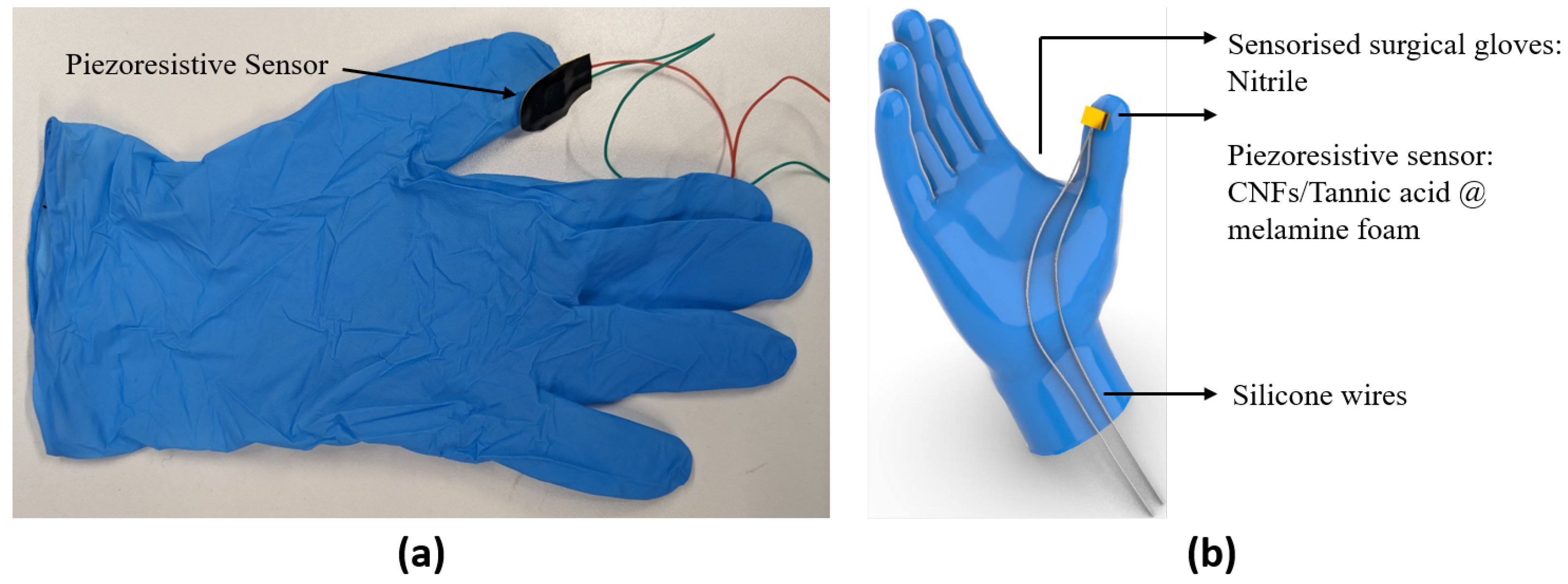
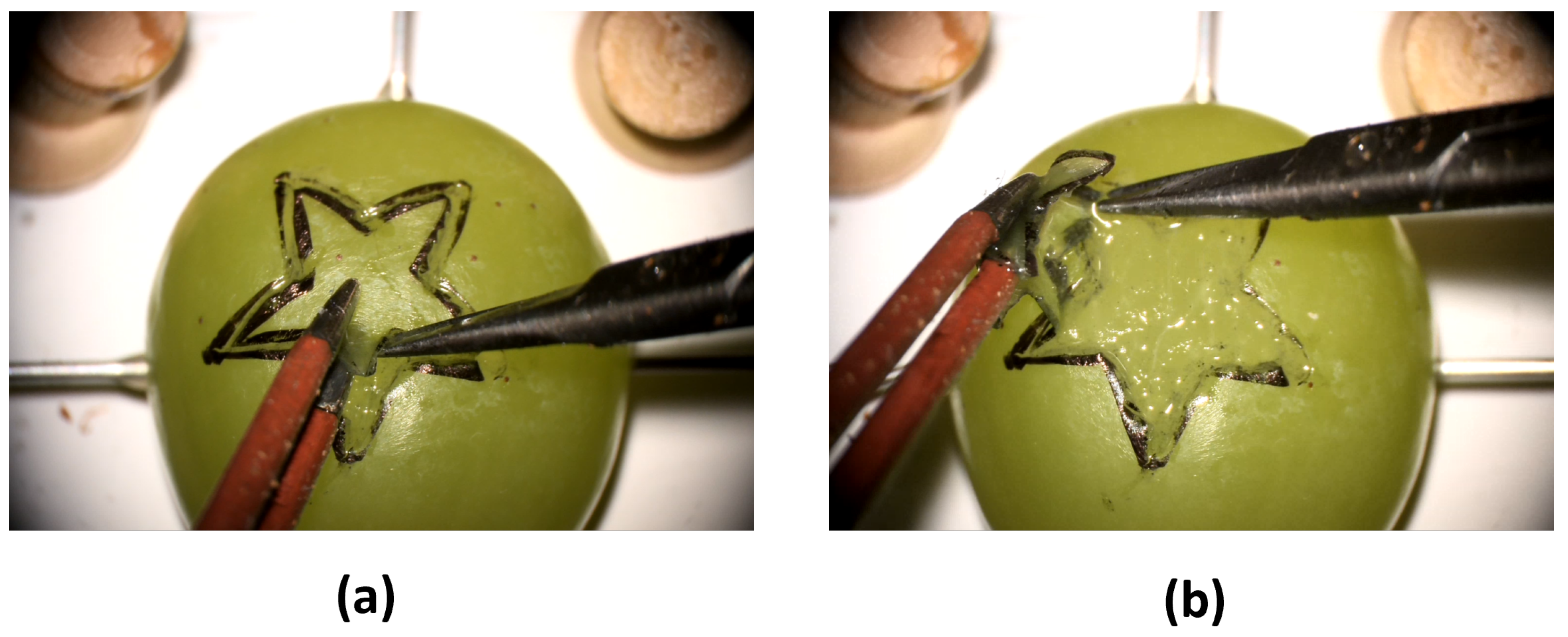
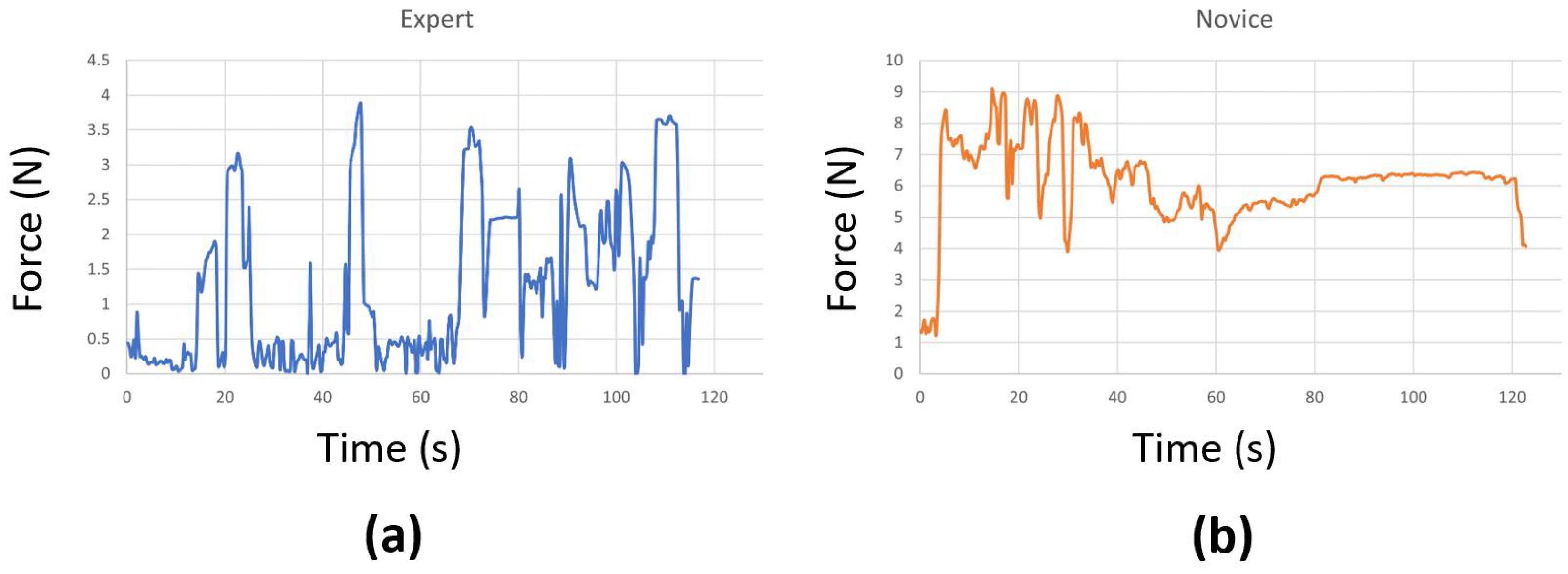

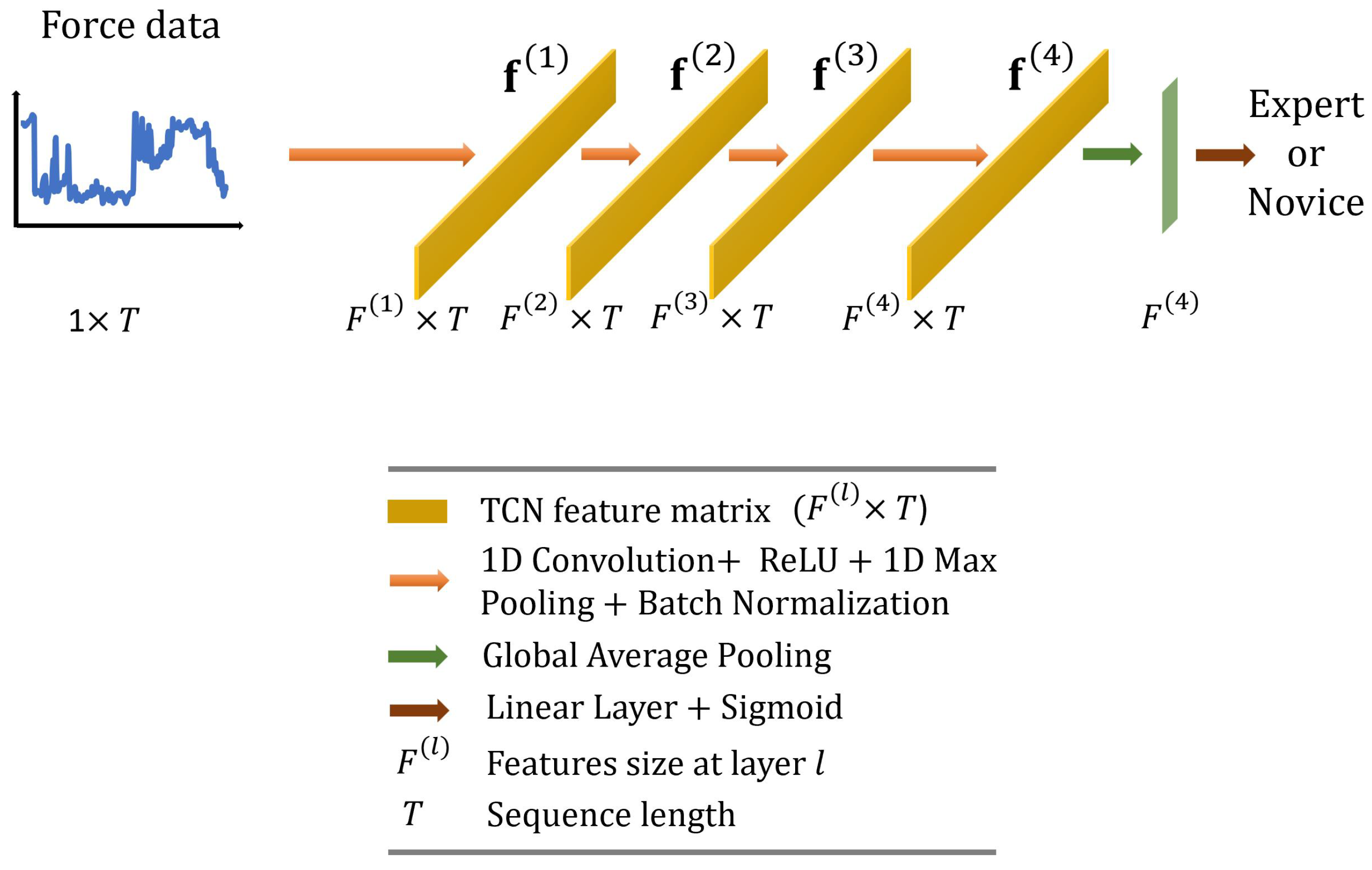
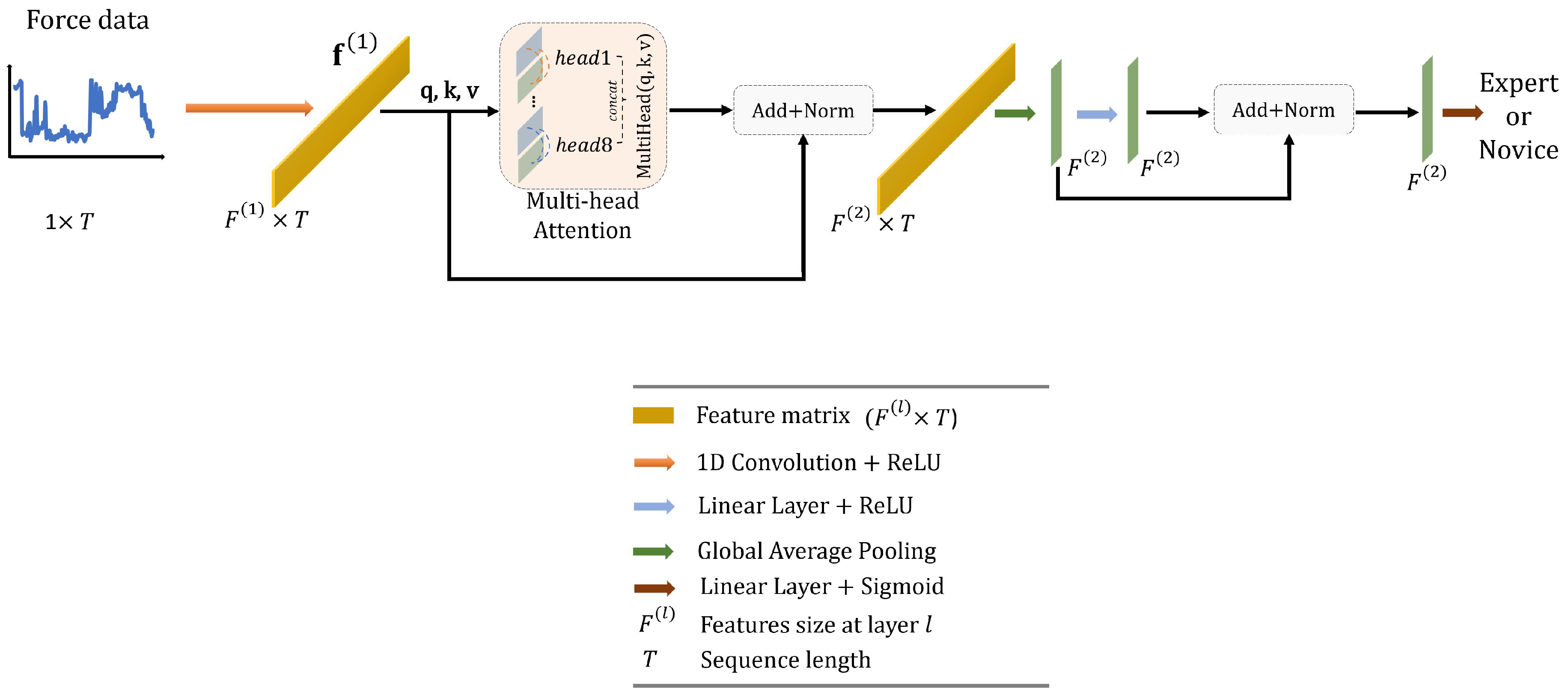
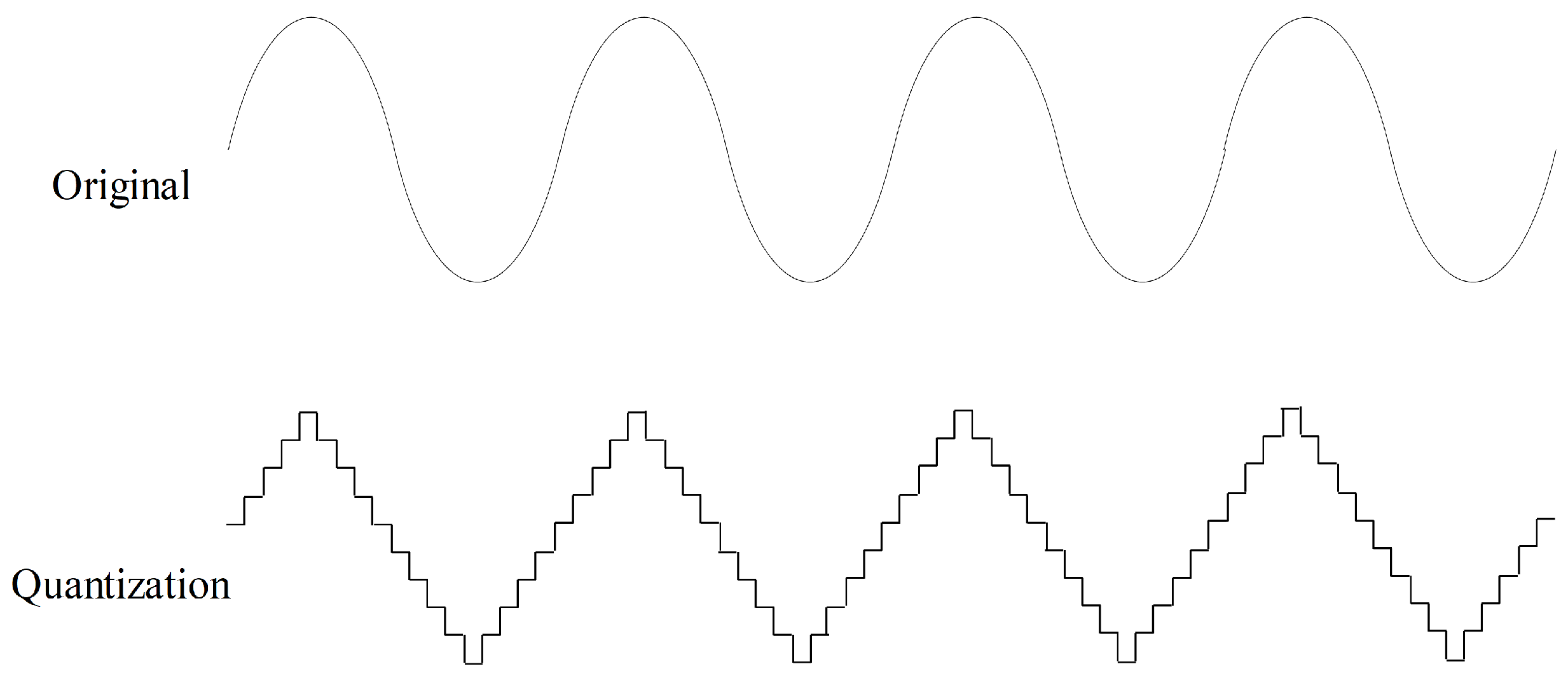
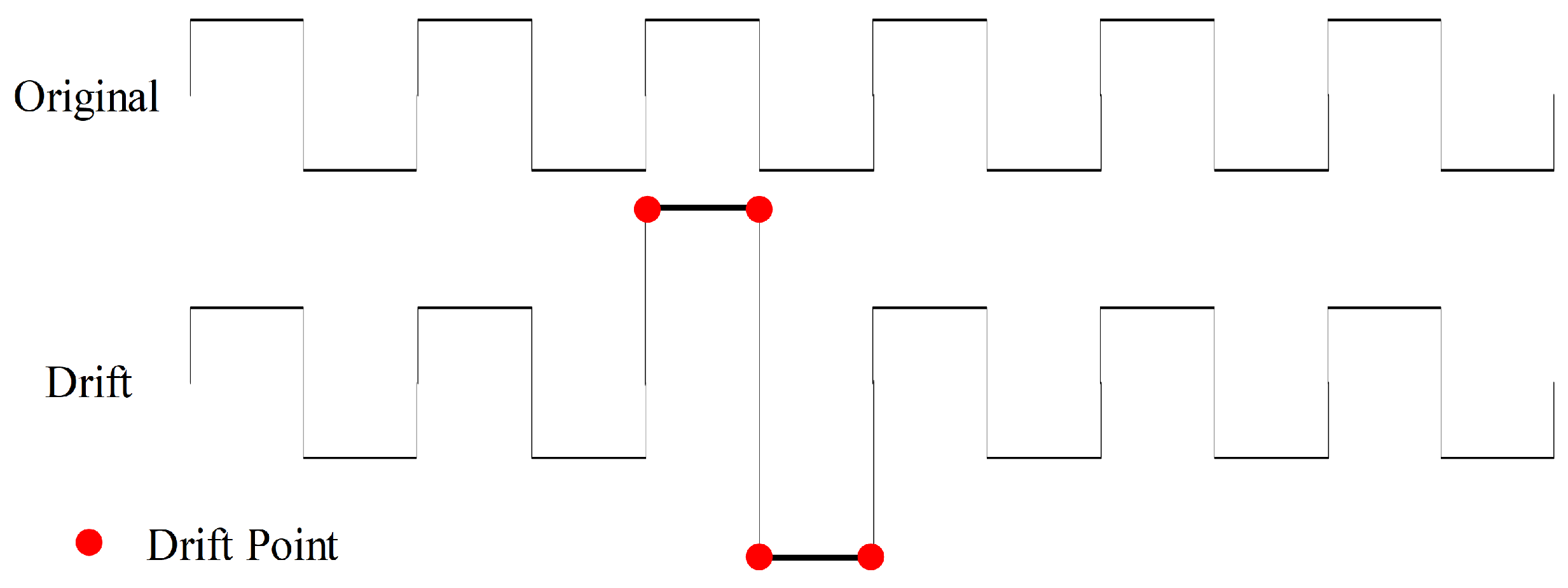

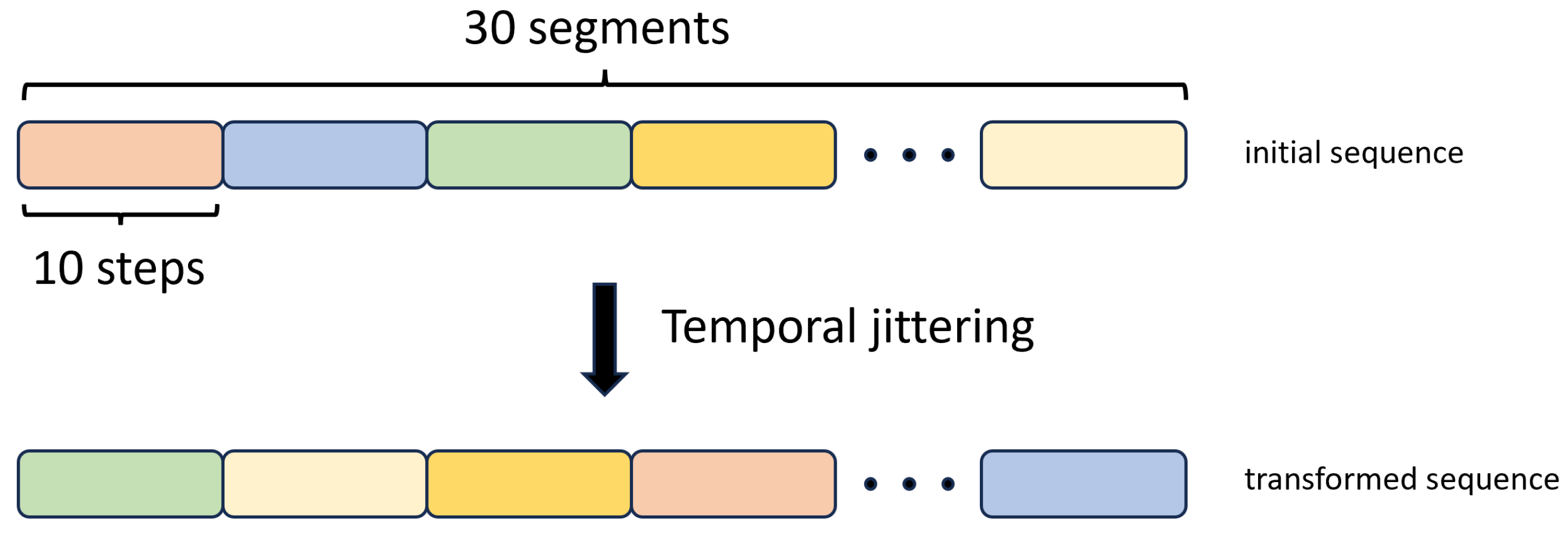

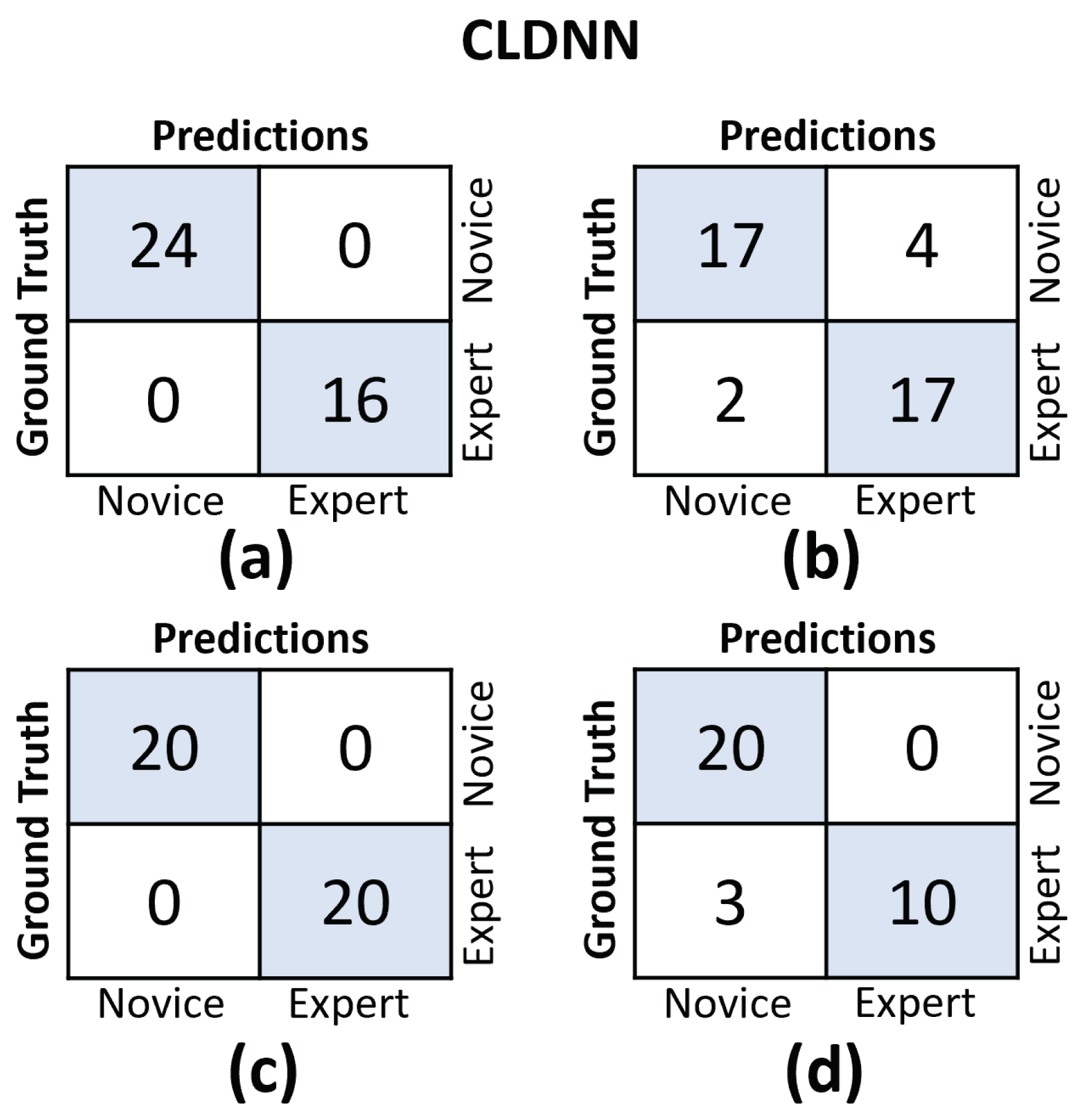

| Method | Accuracy | F1-Score | Precision | Recall |
|---|---|---|---|---|
| GRU | 75.46 ± 5.05 | 76.08 ± 4.17 | 73.96 ± 9.74 | 80.36 ± 8.74 |
| LSTM | 78.86 ± 7.40 | 76.91 ± 5.30 | 88.58 ± 16.58 | 71.15 ± 9.90 |
| Bi-LSTM | 80.51 ± 4.06 | 77.98 ± 4.42 | 87.45 ± 7.49 | 71.72 ± 9.43 |
| CLDNN | 93.65 ± 5.39 | 93.51 ± 5.29 | 92.63 ± 6.84 | 94.56 ± 4.44 |
| TCN | 97.45 ± 3.63 | 97.51 ± 3.37 | 97.54 ± 3.70 | 97.54 ± 3.70 |
| Transformer | 90.67 ± 3.20 | 89.77 ± 3.93 | 94.71 ± 6.21 | 85.71 ± 5.29 |
| Method | Accuracy | F1-Score | Precision | Recall |
|---|---|---|---|---|
| GRU | 77.57 ± 10.88 | 74.55 ± 15.91 | 78.62 ± 13.30 | 76.97 ± 22.72 |
| LSTM | 76.67 ± 14.33 | 72.43 ± 21.46 | 78.50 ± 14.50 | 74.56 ± 26.36 |
| Bi-LSTM | 84.92 ± 9.94 | 80.65 ± 15.06 | 90.39 ± 11.34 | 76.37 ± 21.24 |
| CLDNN | 96.19 ± 3.22 | 95.54 ± 4.36 | 98.33 ± 3.73 | 93.44 ± 8.24 |
| TCN | 88.95 ± 14.80 | 88.44 ± 14.63 | 90.00 ± 18.26 | 92.16 ± 17.54 |
| Transformer | 86.68 ± 13.37 | 83.42 ± 19.73 | 88.2 ± 16.11 | 86.95 ± 25.89 |
| Method | Accuracy (%) | F1-Score (%) | Precision (%) | Recall (%) |
|---|---|---|---|---|
| CLDNN (no augmentations) | 93.65 ± 5.39 | 93.51 ± 5.29 | 92.63 ± 6.84 | 94.56 ± 4.44 |
| CLDNN-FFT | 93.24 ± 4.73 | 93.63 ± 4.24 | 91.21 ± 6.69 | 96.49 ± 3.74 |
| CLDNN-drift | 92.36 ± 2.12 | 92.03 ± 2.68 | 91.70 ± 6.54 | 92.88 ± 4.43 |
| CLDNN-quantize | 93.23 ± 4.48 | 93.43 ± 4.16 | 92.46 ± 8.08 | 95.03 ± 4.00 |
| CLDNN-timewarp | 93.21 ± 3.15 | 92.81 ± 3.65 | 96.52 ± 3.64 | 89.67 ± 6.33 |
| CLDNN-Gaussian noise | 92.79 ± 4.94 | 92.50 ± 5.39 | 93.13 ± 7.45 | 92.99 ± 9.37 |
| CLDNN-temporal jittering | 91.12 ± 3.11 | 90.73 ± 3.42 | 90.28 ± 7.25 | 91.87 ± 5.70 |
| TCN (no augmentations) | 97.45 ± 3.63 | 97.51 ± 3.37 | 97.54 ± 3.70 | 97.54 ± 3.70 |
| TCN-FFT | 95.75 ± 2.85 | 95.39 ± 2.85 | 96.73 ± 4.64 | 94.28 ± 3.65 |
| TCN-drift | 97.02 ± 3.75 | 97.04 ± 3.56 | 97.49 ± 3.73 | 96.61 ± 3.66 |
| TCN-quantize | 96.61 ± 2.83 | 96.35 ± 2.93 | 97.56 ± 3.60 | 95.32 ± 4.20 |
| TCN-timewarp | 97.46 ± 2.56 | 97.40 ± 2.35 | 97.61 ± 3.56 | 97.29 ± 2.75 |
| TCN-Gaussian noise | 97.45 ± 2.56 | 97.40 ± 2.35 | 97.61 ± 3.56 | 97.29 ± 2.75 |
| TCN-temporal jittering | 95.33 ± 3.12 | 94.88 ± 3.04 | 96.45 ± 3.76 | 93.48 ± 3.87 |
| Method | Accuracy (%) | F1-Score (%) | Precision (%) | Recall (%) |
|---|---|---|---|---|
| CLDNN (no augmentations) | 96.19 ± 3.22 | 95.54 ± 4.36 | 98.33 ± 3.73 | 93.44 ± 8.24 |
| CLDNN-FFT | 90.19 ± 7.77 | 88.29 ± 10.09 | 93.47 ± 10.05 | 86.55 ± 16.39 |
| CLDNN-drift | 94.59 ± 5.42 | 94.21 ± 5.38 | 94.44 ± 9.21 | 94.70 ± 5.32 |
| CLDNN-quantization | 96.36 ± 4.43 | 95.56 ± 5.72 | 97.44 ± 5.73 | 93.92 ± 6.88 |
| CLDNN-timewarp | 96.48 ± 2.74 | 95.89 ± 3.73 | 97.73 ± 3.33 | 94.22 ± 5.21 |
| CLDNN-Gaussian noise | 88.67 ± 9.47 | 86.68 ± 12.47 | 90.78 ± 13.87 | 87.66 ± 18.97 |
| CLDNN-temporal swapping | 92.39 ± 6.45 | 92.40 ± 6.77 | 88.35 ± 10.44 | 97.44 ± 3.63 |
| TCN (no augmentations) | 88.95 ± 14.80 | 88.44 ± 14.63 | 90.00 ± 18.26 | 92.16 ± 17.54 |
| TCN-FFT | 94.96 ± 5.35 | 94.10 ± 6.97 | 94.84 ± 7.33 | 93.72 ± 8.59 |
| TCN-drift | 89.46 ± 13.85 | 88.73 ± 14.20 | 90.33 ± 17.53 | 92.16 ± 17.54 |
| TCN-quantization | 89.57 ± 13.06 | 87.55 ± 16.36 | 91.09 ± 15.88 | 90.20 ± 21.92 |
| TCN-timewarp | 90.36 ± 13.26 | 90.29 ± 12.37 | 90.33 ± 17.53 | 94.12 ± 13.15 |
| TCN-Gaussian noise | 90.59 ± 10.88 | 88.55 ± 14.11 | 91.48 ± 13.70 | 89.89 ± 19.36 |
| TCN-temporal jittering | 89.32 ± 12.74 | 86.62 ± 17.82 | 91.52 ± 14.95 | 88.74 ± 23.93 |
Disclaimer/Publisher’s Note: The statements, opinions and data contained in all publications are solely those of the individual author(s) and contributor(s) and not of MDPI and/or the editor(s). MDPI and/or the editor(s) disclaim responsibility for any injury to people or property resulting from any ideas, methods, instructions or products referred to in the content. |
© 2023 by the authors. Licensee MDPI, Basel, Switzerland. This article is an open access article distributed under the terms and conditions of the Creative Commons Attribution (CC BY) license (https://creativecommons.org/licenses/by/4.0/).
Share and Cite
Xu, J.; Anastasiou, D.; Booker, J.; Burton, O.E.; Layard Horsfall, H.; Salvadores Fernandez, C.; Xue, Y.; Stoyanov, D.; Tiwari, M.K.; Marcus, H.J.; et al. A Deep Learning Approach to Classify Surgical Skill in Microsurgery Using Force Data from a Novel Sensorised Surgical Glove. Sensors 2023, 23, 8947. https://doi.org/10.3390/s23218947
Xu J, Anastasiou D, Booker J, Burton OE, Layard Horsfall H, Salvadores Fernandez C, Xue Y, Stoyanov D, Tiwari MK, Marcus HJ, et al. A Deep Learning Approach to Classify Surgical Skill in Microsurgery Using Force Data from a Novel Sensorised Surgical Glove. Sensors. 2023; 23(21):8947. https://doi.org/10.3390/s23218947
Chicago/Turabian StyleXu, Jialang, Dimitrios Anastasiou, James Booker, Oliver E. Burton, Hugo Layard Horsfall, Carmen Salvadores Fernandez, Yang Xue, Danail Stoyanov, Manish K. Tiwari, Hani J. Marcus, and et al. 2023. "A Deep Learning Approach to Classify Surgical Skill in Microsurgery Using Force Data from a Novel Sensorised Surgical Glove" Sensors 23, no. 21: 8947. https://doi.org/10.3390/s23218947
APA StyleXu, J., Anastasiou, D., Booker, J., Burton, O. E., Layard Horsfall, H., Salvadores Fernandez, C., Xue, Y., Stoyanov, D., Tiwari, M. K., Marcus, H. J., & Mazomenos, E. B. (2023). A Deep Learning Approach to Classify Surgical Skill in Microsurgery Using Force Data from a Novel Sensorised Surgical Glove. Sensors, 23(21), 8947. https://doi.org/10.3390/s23218947






